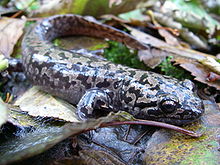Pacific giant salamander - Simple English Wikipedia, the free encyclopedia
| Pacific giant salamanders Temporal range: Paleocene to recent, | |
|---|---|
 | |
| Dicamptodon tenebrosus | |
| Scientific classification | |
| Domain: | Eukaryota |
| Kingdom: | Animalia |
| Phylum: | Chordata |
| Class: | Amphibia |
| Order: | Urodela |
| Family: | Ambystomatidae |
| Genus: | Dicamptodon Strauch, 1870 |

A Pacific giant salamander (Dicamptodon) is a member of the family and genus of large salamanders.
The salamanders may grow up to 30 cm (12 in) long, and are found in the Pacific Northwest of North America. Apart from their large size, they are like the mole salamander family (Ambystomatidae).[1]
Most salamanders are silent but the Pacific giant salamander can make noise. The adults can live on land or in water.
The genus has four species: Cope's giant salamander (D. copei), the Idaho giant salamander (D. aterrimus), the coastal giant salamander (D. tenebrosus), and the California giant salamander (D. ensatus).[2]
References
[change | change source]- ↑ Frost, Darrel R. et al 2006. The amphibian tree of life. Bulletin of the AMNH #297 [1] Archived 2016-08-11 at the Wayback Machine
- ↑ David A. Goode (1989). "Hybridization and cryptic species in Dicamptodon (Caudata: dicamptodontidae)". Evolution. 43 (4): 728–744. doi:10.2307/2409302. JSTOR 2409302. PMID 28564189.
Other websites
[change | change source] Data related to Dicamptodon at Wikispecies
Data related to Dicamptodon at Wikispecies Media related to Dicamptodon at Wikimedia Commons
Media related to Dicamptodon at Wikimedia Commons- Tree of Life: Dicamptodontidae Archived 2019-05-07 at the Wayback Machine
- Dicamptodon at CalPhotos


 French
French Deutsch
Deutsch